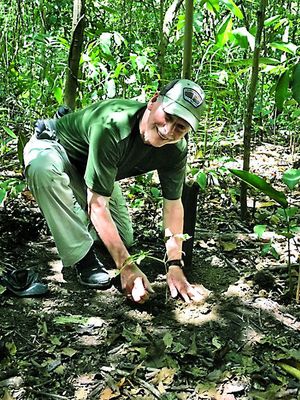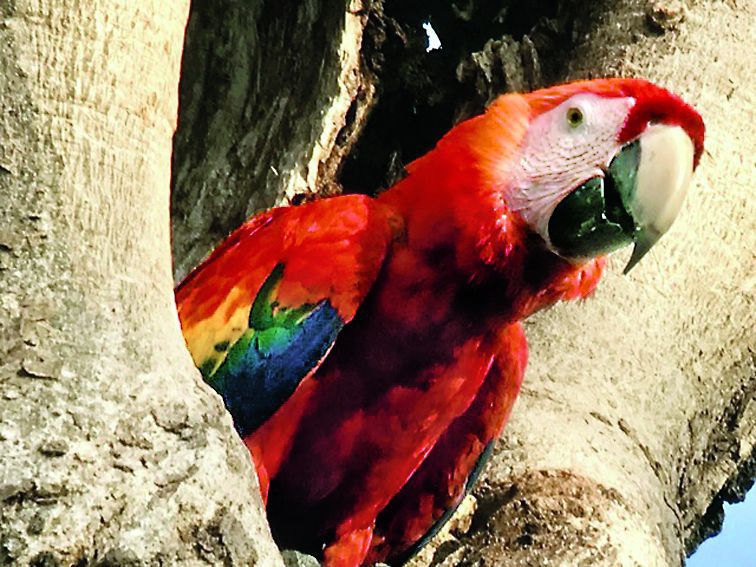Costa Rica Travel – The sounds of the rainforest awaken me without fail. No need for an alarm clock here. Often, it is a howler monkey roar, like the refrain of a rondo, interspersed with various bird and insect calls. In the dark, at 4:30 a.m., the howler’s roar can stand my hair on end.
 Suddenly the high pitched, unrelenting drone of cicadas is followed by the beautiful chirps of the bright-rumped attila or the repetitive sounds of the laughing falcon. At times it is an annoying cacophony of sounds, while at times it is melodious.
Suddenly the high pitched, unrelenting drone of cicadas is followed by the beautiful chirps of the bright-rumped attila or the repetitive sounds of the laughing falcon. At times it is an annoying cacophony of sounds, while at times it is melodious.
Like the conductor bringing various instruments into play, sounds of the macaws, wild chickens, toucans and whistling birds serve as my snooze alarm.
Some sounds give the illusion of children at play. The steady splash of waves against the beaches are also audible, despite being a twenty-minute downhill hike from my open-air bungalow. I have a great overview of the bay and distant hills, and once awakened, I lie in bed or sit on the deck and watch a beautiful sunrise greet the birds flying to and fro over the lush vegetation, while monkeys begin foraging.
Personally, this place is paradise. It is an example of excellence in sustainable tourism. Located on the southwestern pacific side of Costa Rica, at the tip of the Osa Peninsula, Lapa Rios is a National Geographic Unique Lodge. There are seventeen private bungalows built in harmony with the environment along three ridges 350 feet above sea level. This is a private nature reserve that covers 1000 acres of some of the last remaining lowland tropical forest in Central America.
Having visited other areas of Costa Rica previously, I knew that this would be an ideal, one-week quick getaway adventure for me. Costa Rica ranks third (Sweden is number one) in performance among the top ten greenest countries in the world, by the Global Green Economy Index. The entire country focuses on universal recycling and renewable energy (generated from sunlight, wind, rain, tides and geothermal heat) practices.
Although the “green season” (from May to November) is the most lush and best time to experience a true rainforest, I chose early April, the end of the “dry season”, for convenience, various adventures, and an arguably better opportunity for wildlife photography. The trip there was long, worsened by flight delays. But it was worth it. I flew from Austin to Atlanta, then on to San Jose before transfer to Puerto Jimenez. There I was met by a private driver who provided me with a pipa (a coconut with straw) drink and cookies. He was very knowledgeable and pointed out wildlife all along the twenty-mile, bumpy dirt-road to Lapa Rios.
Many tours, led by expert naturalists, were included in the lodging costs. These included educational hikes regarding the medicinal use of plants and trees, the biodiversity of the rainforest and the beaches, birdwatching, and a night walk. There were self-guided nature trails, guided hikes that crossed the entire thousand acres of forest, and hikes to waterfalls. I participated in all of these. In addition, I planted a tree (“garlic tree”, named for the smell of its leaves; Cariocar costaricense) as a tourist participant in the preservation of the rainforest.
Our hiking took us through primary and secondary rainforests, differentiated by the age and size of trees, as well as by the amount of sunlight that could filter through the canopy. Outside activities included waterfall rappelling and horseback riding. Other activities available that I did not participate in this time included paddle boarding, zip lining, surfing, fishing, snorkeling, kayaking, and dolphin watching. By report, there were some beautiful snorkeling areas, despite the loss of a beautiful reef in nearby Rincon Bay due to prior timbering activities and erosion into it. Despite all the activities, there were several hours daily during which I could just relax and be absorbed by the beauty of my surroundings.
Some of my favorite wildlife included the blue morpho butterflies, three-toed sloths, white-nosed coatis, agoutis, poison dart frogs, iguanas, lizards, and Halloween crabs. Monkeys were the most entertaining. There were four species of monkeys seen: spider, squirrel, white-faced capuchin, and howler. Among the birds, I saw macaws, toucans, parrots, parakeets, caracara hawks (including some juveniles nesting), manakins, woodcreepers, wrens, flycatchers, egrets, tanagers, sparrows, blue herons, honeycreepers, brown pelicans, roadside and black hawks, and an occasional beautiful trogon.
Being located at the lowest bungalow on the hillside had its advantages. Extra exercise was one, as I hiked 504 steps uphill to the central lodge for meals and to meet for activities, at least three or four times daily. During those times, I got to see many of the birds and animals noted above, as well as enjoyed the lush vegetation along the way. I was also the closest bungalow to the beaches, and could catch an early morning walk there before breakfast.
Rainy season was not supposed to start until May, three weeks away. Foolish me, however, believed the forecast of daily thunderstorms for my one week stay in this rainforest, so I left my new 150- 600 mm Canon lens at home, settling for a walk-around and easier to protect Sony that was only one-third that zoom.
We got less than thirty minutes of rain total, as each day of my stay was sunny, hot, and humid. My regrets were partly allayed by our knowledgeable naturalist guide who showed me how to use my i-phone camera with his spotting telescope to get some beautiful photos from a distance. Nevertheless, my big lens will be at my side on my next trip to paradise.
Dr. Burke is a retired pediatrician who lives in Temple and is the author of “Beyond the Quest to Become a Physician”. His medical blogs can be followed at www.reburkemd.com

